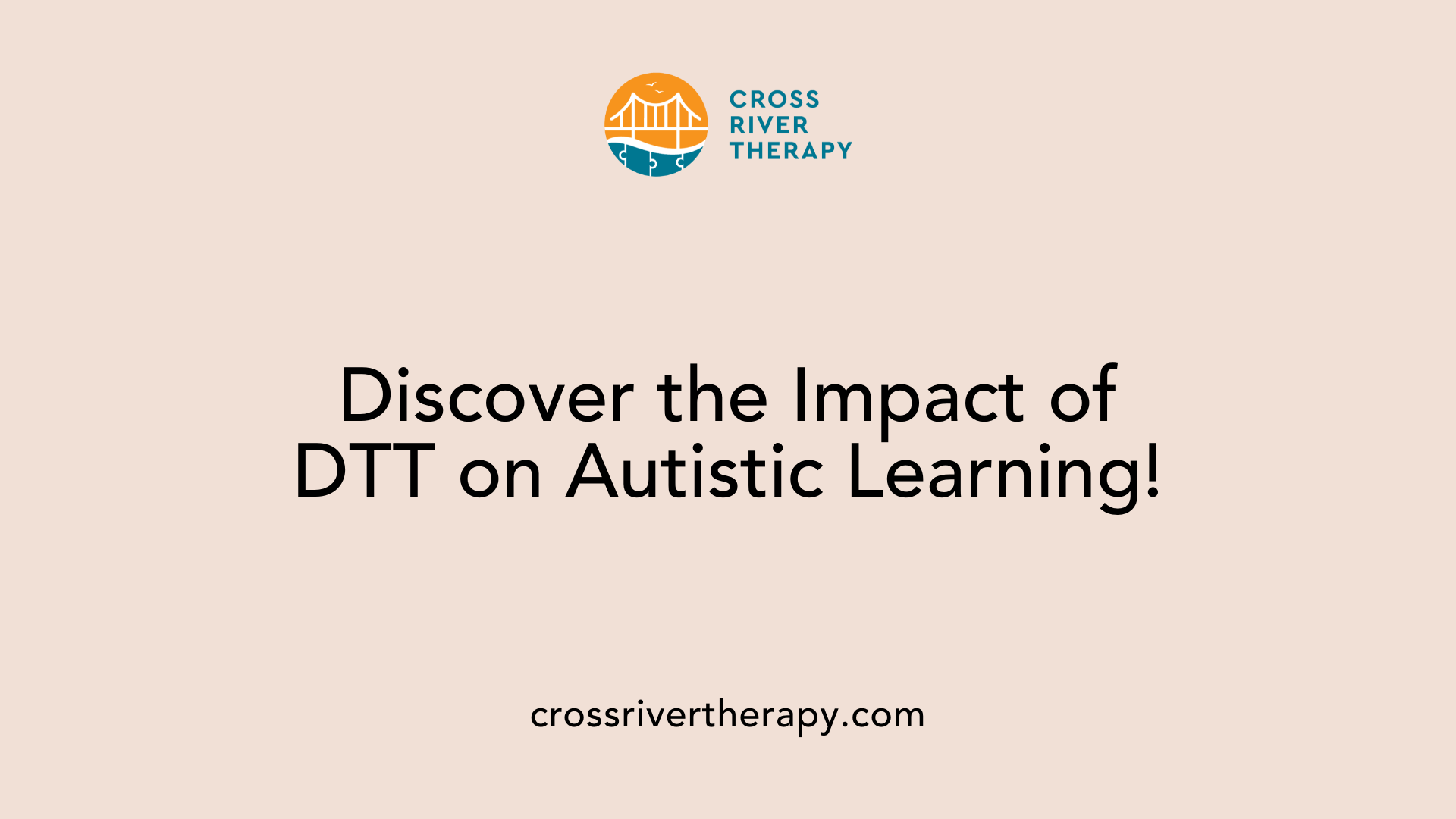The Role of Discrete Trial Training (DTT) in ABA Therapy
Exploring the Impact of Discrete Trial Training in Autism Support
Introduction to Discrete Trial Training in ABA Therapy
As a cornerstone of Applied Behavior Analysis (ABA), Discrete Trial Training (DTT) offers a structured approach to teaching skills to children with autism. Recognized for its systematic method of instruction, DTT breaks down complex skills into smaller, manageable parts, ensuring focused learning and skill acquisition. This article delves into the role of DTT within ABA therapy, exploring its methodologies, effectiveness, and how it stands apart from other ABA strategies.
Understanding Discrete Trial Training

What does DTT mean in ABA therapy?
DTT stands for Discrete Trial Training, a systematic and structured teaching method utilized in Applied Behavior Analysis (ABA). It is particularly designed for children with autism, enabling them to learn new skills by breaking down complex tasks into simpler, manageable steps. This structured approach encourages learning through repetition and reinforcement, often using tangible rewards like praise or tokens to motivate desired behaviors.
The methodology behind DTT
The DTT methodology consists of five main components that create a clear framework for instruction:
- Discriminative Stimulus: The initial instruction given by the trainer, prompting the child to respond.
- Prompting: Assistance provided to help the child formulate a response if necessary.
- Response: The behavior or answer given by the child.
- Consequence: Feedback provided based on whether the child's response is correct, which may include reinforcement for positive answers or corrective feedback.
- Inter-Trial Interval: A brief pause to prepare for the next trial, maintaining the flow of learning.
This structured environment fosters effective learning, allowing educators to focus on specific skills and track progress through data collection—monitoring correct and incorrect responses to tailor teaching methods for individual students.
The historical development of DTT
The development of Discrete Trial Training traces back to the 1970s, pioneered by Dr. Ivar Lovaas, who aimed to address severe autism-related learning deficits. Through extensive research and practical application, DTT emerged as one of the first interventions for autism, showcasing positive effects on children’s behavioral and skill development. Over the years, it has evolved but remains a cornerstone of effective ABA practices, supported by ongoing research and integration with other therapeutic approaches to comprehensively address various developmental areas.
The Importance of DTT in Enhancing Learning for Children with Autism

Why is discrete trial training important?
Discrete Trial Training (DTT) plays a pivotal role in the education of children with autism by providing a structured framework for skill acquisition.
Utilizing a methodical approach, DTT breaks down complex tasks into smaller, manageable components. This segmentation allows children to focus on one skill at a time, leading to more effective learning.
Structure and reinforcement in DTT
DTT is characterized by its structured format that comprises several critical elements:
- Antecedent: Clear instruction or prompt given by the trainer.
- Response: The child's behavior or answer following the prompt.
- Consequence: Immediate feedback or reinforcement based on the child's response.
- Inter-trial Interval: A brief pause before the next teaching attempt.
The combination of these elements fosters a predictable learning environment. Tangible rewards serve as motivation, enhancing the child's focus and engagement, which are crucial for children with autism.
DTT's role in developmental progress
The effectiveness of DTT has been supported by extensive research showing its positive impact on various skills, including communication, social interactions, and daily living. Given that DTT encourages mastery before progressing to more challenging tasks, it ensures children achieve a solid foundation.
By promoting comprehension over rote memorization, DTT helps children generalize skills across different contexts, fostering independence. As a result, DTT stands out as a crucial method in Applied Behavioral Analysis (ABA) for enhancing learning and overall development in autistic children.
DTT versus Naturalistic Teaching Approaches

Comparison between DTT and other ABA methods
Discrete Trial Training (DTT) and naturalistic teaching approaches, like Natural Environment Teaching (NET), serve distinct yet complementary roles in the education of children with autism. DTT is characterized by its structured methodology, where learning is broken down into small, manageable components that are taught systematically. Typically executed in a distraction-free environment, DTT emphasizes repetition, accuracy tracking, and immediate reinforcement.
In contrast, naturalistic teaching infuses learning into daily activities, capitalizing on the child’s interests and existing behaviors to promote engagement. This flexibility often reinforces skills in a more relatable context, allowing children to practice their abilities in real-world scenarios without the constraints of a structured setting.
Structure versus natural environment learning
The stark difference between DTT and naturalistic methods lies primarily in their environments and instructional styles. DTT provides a consistent framework aimed at facilitating rote memorization and immediate feedback, which can significantly aid in skill acquisition. Often, the structured setting may serve as the ideal foundation for early learners.
On the other hand, naturalistic methods enhance skill generalization and application beyond formal learning sessions. They bridge classroom skills with social domains, helping children apply what they've learned at home and in the community.
Benefits of integrating different approaches
Integrating DTT with naturalistic teaching can potentially yield optimal outcomes. DTT lays the groundwork by instilling key skills, while natural approaches advocate for the flexibility necessary to adapt in varied social situations. Many children on the autism spectrum thrive when introduced to a hybrid model, balancing structured instruction with opportunities for spontaneous and natural learning.
This tailored approach ensures that the unique needs of each child are met, enabling a more holistic educational experience that fosters both independence and practical skill usage.
Implementing Discrete Trial Instruction

Steps in conducting DTT
Implementing Discrete Trial Training (DTT) encompasses several defined steps to ensure effective skill acquisition. These steps include:
- Antecedent: The trainer presents a clear instruction or question to prompt the child.
- Prompt: Assistance may be given to help the child respond correctly (e.g., verbal cues, physical guidance).
- Response: The child provides a response, which can be correct or incorrect.
- Consequence: Based on the response, the child receives reinforcement for a correct answer or a corrective prompt for an incorrect answer.
- Inter-trial Interval: A brief pause allows for the transition to the next teaching attempt, maintaining continuity and focus.
Role of reinforcement in DTT
Reinforcement is fundamental in DTT, as it drives motivation and encourages desired behaviors. When a child responds correctly, they often receive tangible rewards, praise, or other incentives, which help solidify the learning experience. This reinforcement can be continuous or intermittent, depending on the learning objectives and progress, and is critical for promoting long-term retention of skills.
Data collection and analysis importance
Data collection in each discrete trial is vital for tracking student progress and assessing the effectiveness of teaching strategies. Progress notes typically include correct and incorrect responses, allowing educators to identify patterns and adjust instructional techniques as necessary. Analyzing this data ensures that each child receives tailored support, facilitating optimal learning conditions that can adapt to their evolving needs.
DTT’s structured nature, combined with precise data collection and reinforcement strategies, makes it an effective tool in teaching essential skills to children with autism.
Practical Examples of Discrete Trial Training

Illustrative Applications of DTT
Discrete Trial Training (DTT) is particularly effective in structured settings for teaching specific skills to children with autism. For instance, in a common DTT scenario, a trainer may teach a child to recognize colors. Here, the instructor presents the stimulus—say, the color "red"—and asks the child to point to a red object. If needed, the trainer might use a verbal prompt to facilitate the child's response.
When the child identifies the color correctly, the trainer provides immediate reinforcement, which could be a sticker or verbal praise. This rewarding approach encourages the child to engage and reinforces the learning process. Once the child has mastered "red," the trainer introduces another color, such as "yellow," following the identical structure.
Skill Acquisition Through DTT
DTT not only emphasizes breaking down skills but also facilitates gradual skill acquisition. It often ranges from basic skills, like color recognition, to more complex tasks such as social communication and self-help skills. Each skill is taught in small, manageable steps, allowing students to master one before progressing to the next.
Key components involve repeated trials and consistent reinforcement, ensuring that children receive clear feedback on their responses. This structured approach, tailored to individual learning needs, helps maximize the effectiveness of DTT in promoting independence and enhancing various skill areas for autistic children.
Framework for DTT Implementation
What are the steps involved in implementing discrete trial training?
Implementing Discrete Trial Training (DTT) involves a systematic and structured process aimed at teaching specific skills. Here’s a breakdown of the essential steps:
- Assessment and Task Analysis: Identify the skill to be taught and break it down into smaller, manageable components.
- Antecedent Presentation: Introduce a clear instruction or prompt that will elicit a desired behavior from the child.
- Prompting: Provide assistance as needed to help the child respond correctly. This could include gestures, verbal prompts, or visual aids.
- Response: The child performs the behavior or skill in response to the antecedent.
- Consequence: Deliver reinforcement for correct responses, which can include verbal praise, stickers, or other rewards. If the response is incorrect, no reinforcement is given.
- Inter-Trial Interval: Include a brief pause before proceeding to the next trial. This helps maintain focus and allows for processing time.
How do reinforcement and data collection play a role in DTT?
Reinforcement is integral to the DTT framework, designed to motivate and guide the child toward mastering the skill. Positive reinforcement can significantly enhance learning by providing immediate feedback for correct answers, making learners more receptive to the instruction.
Data collection is equally crucial in DTT implementation. It involves tracking each trial’s outcomes—both correct and incorrect responses—which allows educators to evaluate the effectiveness of their teaching method. This data also informs decisions about when to introduce new skills or modify teaching approaches to better suit the learner's evolving needs.
To summarize, the thoughtful integration of structured steps, positive reinforcement, and meticulous data collection forms the backbone of DTT, ensuring that children with autism can effectively learn and generalize new skills.
Conclusion: The Significant Role of DTT in ABA Therapy
Discrete Trial Training (DTT) remains a pivotal component of ABA therapy's approach to supporting children with autism. Its structured methodology, focusing on breaking skills into manageable pieces with consistent reinforcement, has been proven effective in various educational settings. By integrating DTT with other teaching strategies within ABA, therapists can offer a comprehensive approach, tailored to meet individual learning needs and foster the development of essential skills that extend beyond the confines of structured sessions.
References
- What is Discrete Trial Training? | Autism Speaks
- Discrete Trial Teaching: What is it?: Articles
- Discrete Trial Training (DTT) - Raising Children Network
- [PDF] FACT SHEET – DISCRETE TRIAL
- Discrete Trial Training: A Complete Guide for Parents - Blue ABA
- DTT ABA- Discrete Trial Teaching in Applied Behavior Analysis
- Discrete Trial Training (DTT) - ABA Therapist Jobs



